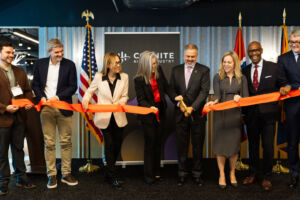Even when the state was known for copper, cattle and citrus, Arizona has relied on being an innovator to drive its economy.
“Arizona’s economic position has historically been defined by science and technology,” says Steven M. Shope, president of Mesa-based Sandia Research Corporation, “especially if you look back to the 1940s and 1950s, when the state put a wealth of resources into attracting new technologies.”
Those efforts, Shope says, paid off and made Arizona a leader in the electronics, semiconductor, aerospace and defense industries.
“Now, we need more science and technology to transform Arizona into a knowledge economy and lift our productivity and export growth from below national average,” Shope says.
To help make that happen, the Greater Phoenix Economic Council (GPEC) has directed its Innovation Council — which is co chaired by Shope and Todd Hardy, associate vice president of economic affairs for Arizona State University — to study the community’s high-potential assets, look for commercialization opportunities and put together and science and technology strategy that will help drive a knowledge-based economy in Arizona. The backbone of that strategy will be building on the state’s existing strengths.
According to Sethuraman Panchanathan, senior vice president at ASU’s Office of Knowledge Enterprise Development, those strengths include the state’s world-class research universities, research centers and institutes, a large highly trained workforce, a vibrant entrepreneurship ecosystem, a concerted effort on improving business climate in the cities and the state, plans for rapid growth by existing science and technology businesses, and an enhanced quality of life.
“Our best strengths come from the companies already here — established businesses like Intel, Avnet, Boeing and Honeywell,” Shope says. “Arizona also has lower workforce costs and good transportation connectivity to other markets, both of which are attractive for science- or technology-based businesses.”
So how does Arizona tranlate those assets into further expansion and enhancement of the science and technology sectors?
“We’re already world leaders in solar research and development and manufacturing and there is still strong potential for innovation within our aerospace and electronics industries, as well as in healthcare and personalized medicine,” Shope says. “However, we need to fill in the gaps with regards to access to capital, markets and talent in order to realize that potential. GPEC’s Innovation Council is working to develop a strategy that leverages these resources, harnesses new ones and further diversifies our economy into these areas.”
Panchanathan says the key to creating a successful strategy will be, “Convergence of purpose between the various economic development entities in Arizona, securing investments that can be deployed to attract new businesses to Arizona, and creating incentives for attracting local and global businesses to Arizona.”
Already driving Arizona’s electronics sector is Intel, with its recent $5 billion expansion, and companies like Boeing and Honeywell are fueling the aerospace sector. Those three companies are driving innovation within our communities and their local supply chains, Shope points out.
Top develop its science and technology strategy, Shope says says GPEC’s Innovation Council is conducting a deep market analysis to identify long-term opportunities in science and technology, and learning how to target growth from initiatives in other regions. GPEC is building the business case among private leaders to establish focus and build resources around a few select initiatives.
“A well thought-out strategy should include building up each community’s unique assets and driving growth into new markets by establishing centers of excellence around emerging products and technologies,” Shope says. “Increasing funding to the universities for R&D is also critical, as is developing funding and resources for entrepreneurs. Educating the entrepreneur is also an important goal. In particular, R&D funding from federal sources, such as (Small Business Innovation Research) SBIR and (Small Business Technology Transfer Program) STTR, is an ideal mechanism for launching new technologies. However, this funding is becoming increasingly competitive. We need to be sure that Arizona small businesses can be highly competitive in these funding programs.”



